SetSince topos theory is about set-like structures lets look at set first and then generalise to other topoi. In set all the subobjects are given by the powerset. |
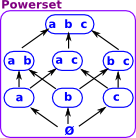 |
This set of all subsets comes with some structure (poset structure), the arrows on the above diagram are inclusion maps or we can think of the arrows as meaning 'is a subset of'.
| All the elements of the powerset are subsets of the set {a,b,c}. Also all the elements are supersets of the empty set ø. Therefore all the subsets are representable (in two ways), that is we can replace all the subsets with arrows. |
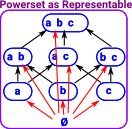 |
Subobject Classifier
See .
See page here for a non-categorical approach to sub-objects.
If the arrow 'f' is monic (injective) then it maps to a subobject (subset) of 'B'. That is: there is a subobject of B that is isomorphic to A. The inclusion relation on subobjects is:
|
 |
In order to define the subobject we must define the monic 'upto equality' which is not in the spirit of category theory. We will go on to define a 'subobject classifier' which defines a subobject, in a much more category theoretic way, by the composition of maps (and also relates the whole subject to logic).
| The classifier (characteristic function in subset case) |  |
| Subset | Classifier |
|---|---|
| ø | {0,0,0} |
| {a} | {1,0,0} |
| {b} | {0,1,0} |
| {c} | {0,0,1} |
| {a,b} | {1,1,0} |
| {a,c} | {1,0,1} |
| {b,c} | {0,1,1} |
| {a,b,c} | {1,1,1} |
Consider the contravariant functor P : Set->Set which maps each set to its power set and each function to its inverse image map. To represent this functor we need a pair (A,u) where A is a set and u is a subset of A, i.e. an element of P(A), such that for all sets X, the hom-set Hom(X,A) is isomorphic to P(X) via ΦX(f) = (Pf)u = f−1(u). Take A = {0,1} and u = {1}. Given a subset S![]() X the corresponding function from X to A is the characteristic function of S.
X the corresponding function from X to A is the characteristic function of S.
Naming Arrows
In category theory we don't usually identify elements, such as elements of a set, because we only tend to determine things 'upto isomorphism'. The objects in a category are whole 'structures', they don't represent individual elements.
However, there is the possibility to indicate elements indirectly using arrows. For instance, if we want to enter a specific element we can use:
1->A
because, in sets, 1 is the single element set so it will indicate an element uniquely.
We can also use naming arrows. An arrow:
f: A->B
Is a subset of a function space f
f :{0}->BA
:{0}->BA
 f
f is called the 'name' of the function.
is called the 'name' of the function.
Classifier
In the opposite direction there is a correspondence between subsets of B and functions:
B->2
This is in the space 2B which corresponds to the powerset![]() (B), that is, all the possible subsets of B.
(B), that is, all the possible subsets of B.
| The characteristic arrow: xf classifies objects of B to determine if they are images of A. This is a pullback square. The object 2 has two values: 0 and 1. We also use the symbol Ω and call the elements 'true' and 'false'. | 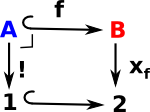 |
This means the topos theory is related to logic. (see also 'characteristic function' in number theory).
Example in Set
| Example in set | |
|---|---|
| Set A (blue) is subset of B (red). |  |
| If we take the inverse of f we get the concept of a 'bundle' as discussed on this page. | 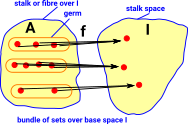 |
classifier for set.
|
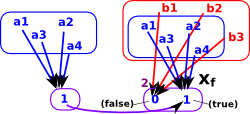 |
Subobject and Fibre
| Here we discuss combining subobject and fibre (taking part of a fibre). | 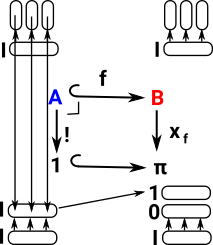 |
| Just to explain the diagram, these two are intended tp be the same: π=(2*I,p1) |  |
Notation
| this can be donated as a pair (A,f) |
I is common and does not need to be specified.



